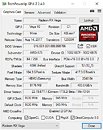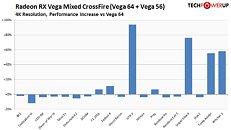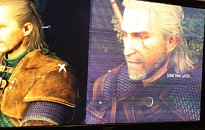Thursday, September 21st 2017

AMD CrossFireX Scaling is Actually Pretty Terrible with Mixed RX Vega
Yes, this is the third post today about AMD introducing multi GPU support for RX Vega with their Crimson ReLive 17.9.2 beta drivers but it had to be made. First up, the caveats- we were only able to test the driver on a CrossFire setup involving one RX Vega 64 and one RX Vega 56 GPU so results with two of the same may differ. Secondly, these are beta drivers so there is a level of lenience here I am willing to afford to AMD. That said, the driver which came with its own announcement and internal results had to show something good and this means showing good scaling across multiple games.
The driver allows CrossFire to be enabled with a mix of the two Vega 10 SKUs, and we set about testing a few games from our GPU benchmark suite using the same testing methodology as always. Tests were done at 4K to minimize a CPU bottleneck of any kind, and the games tested include some of the most popular games today including some that AMD themselves used in the announcement. However, after a few hours of testing, we can simply not recommend using the driver for CrossFire- at least for a mixed setup as we did. More on this after the break.Enabling CrossFire with GPUs that are based off the same die and family but with a different shader count has been something AMD has done for a few generations now, and we continue to appreciate this remaining an option. However, this is no excuse for the performance we are seeing here, be it a driver issue or otherwise. As can be seen from the chart above, a lot of games not only show poor scaling relative to a single RX Vega 64 but actually negative scaling. The negative scaling can potentially be a result of Vega 56 slowing down the Vega 64 card here, but then we are back to zero to minimal scaling again. Of the four games that do, three were in AMD's results chart that went around earlier today as well. This is really disappointing performance, and to make it worse we also faced visual artifacts and display corruption in a few games including Witcher 3 (pictured), Prey and Dishonored 2. We also tried having RX Vega 56 be the primary card to see if that changes anything, and the results were within error margins more often than not with a few results actually being higher (5-10%) than with RX Vega 64 as the primary card. There was also a blue screen that greeted us during the switch, so do not attempt to do so often.
There is another interesting train of thought departing this station of results. AMD has had CrossFire profiles for the previous Polaris (and older) architecture GPUs for most of the games tested here, and they showed consistent, if not great, scaling with those older cards. But based on the inconsistent scaling across game titles here, it appears that AMD may have to create new CrossFire profiles for all games with their RX Vega GPUs based off the Vega microarchitecture. This merits more analysis and testing, but we are definitely curious whether this is indeed the case and, if so, what is the reason behind it knowing that Vega is an evolution of GCN, and not a complete departure from it.
AMD, with Lisa Su temporarily taking over RTG leadership, has a big challenge ahead with the enthusiast graphics solutions market and we can only hope the situation is better with 2x RX Vega 64 (or 56), else this is another thing that is not going to help them.
The driver allows CrossFire to be enabled with a mix of the two Vega 10 SKUs, and we set about testing a few games from our GPU benchmark suite using the same testing methodology as always. Tests were done at 4K to minimize a CPU bottleneck of any kind, and the games tested include some of the most popular games today including some that AMD themselves used in the announcement. However, after a few hours of testing, we can simply not recommend using the driver for CrossFire- at least for a mixed setup as we did. More on this after the break.Enabling CrossFire with GPUs that are based off the same die and family but with a different shader count has been something AMD has done for a few generations now, and we continue to appreciate this remaining an option. However, this is no excuse for the performance we are seeing here, be it a driver issue or otherwise. As can be seen from the chart above, a lot of games not only show poor scaling relative to a single RX Vega 64 but actually negative scaling. The negative scaling can potentially be a result of Vega 56 slowing down the Vega 64 card here, but then we are back to zero to minimal scaling again. Of the four games that do, three were in AMD's results chart that went around earlier today as well. This is really disappointing performance, and to make it worse we also faced visual artifacts and display corruption in a few games including Witcher 3 (pictured), Prey and Dishonored 2. We also tried having RX Vega 56 be the primary card to see if that changes anything, and the results were within error margins more often than not with a few results actually being higher (5-10%) than with RX Vega 64 as the primary card. There was also a blue screen that greeted us during the switch, so do not attempt to do so often.
There is another interesting train of thought departing this station of results. AMD has had CrossFire profiles for the previous Polaris (and older) architecture GPUs for most of the games tested here, and they showed consistent, if not great, scaling with those older cards. But based on the inconsistent scaling across game titles here, it appears that AMD may have to create new CrossFire profiles for all games with their RX Vega GPUs based off the Vega microarchitecture. This merits more analysis and testing, but we are definitely curious whether this is indeed the case and, if so, what is the reason behind it knowing that Vega is an evolution of GCN, and not a complete departure from it.
AMD, with Lisa Su temporarily taking over RTG leadership, has a big challenge ahead with the enthusiast graphics solutions market and we can only hope the situation is better with 2x RX Vega 64 (or 56), else this is another thing that is not going to help them.



73 Comments on AMD CrossFireX Scaling is Actually Pretty Terrible with Mixed RX Vega
Of course this does not mean things will be the same with Vega, as it clearly shows here, but the point of the test was to also see if the old CFX profiles carry over to Vega or not.
I think this is more of a driver thing rather then how good these cards can scale. When crossfire works, they scale almost 100%.
The big culprit of vega is that it's original design was aimed at compute and not gaming. The 56 still makes a good competitor against the 1070.
Where was the outcry when Nvidia started requiring keys for more than two video cards and then just suddenly stopped supporting it all together? Fucking double standards galore.
For people saying hybrid Crossfire isn't a thing you are dead wrong. People even crossfired FuryX and Fury which are both different in clock speed as well as shader units and texture units.
You want proof? Here you go. By AMD RTG employee Matt himself from AMD's own community forum
community.amd.com/thread/186648
More proof:
www.overclock.net/t/1611844/r9-fury-x-r9-fury-crossfire/0_100
Something is seriously wrong with Vega's design. I am sure at the point it is no use to patch a sinking ship.
2015 right after FuryX launch RTG is spun off AMD, then lead by Raja. Now 2017 with Raja giving two consecutive flops Polaris and Vega he is shown the door. I hope Lisa Su can correct the path of RTG before it is too late.
Its not really another VEGA issue its the same issue its always been with multi gpu setups
software support.
In DX11 the cards works pretty well, but in most DX12 games the 390 pretty much sits idle.
In fact not even Time Spy works for my 290X + 390 set up.
Same is true with Sniper Elite 4, crossfire works in DX11, but doesn't work in DX12, which is like the dumbest thing ever since I either get DX12 with Async, or DX11 with crossfire.